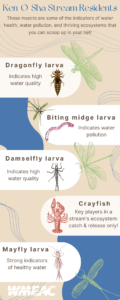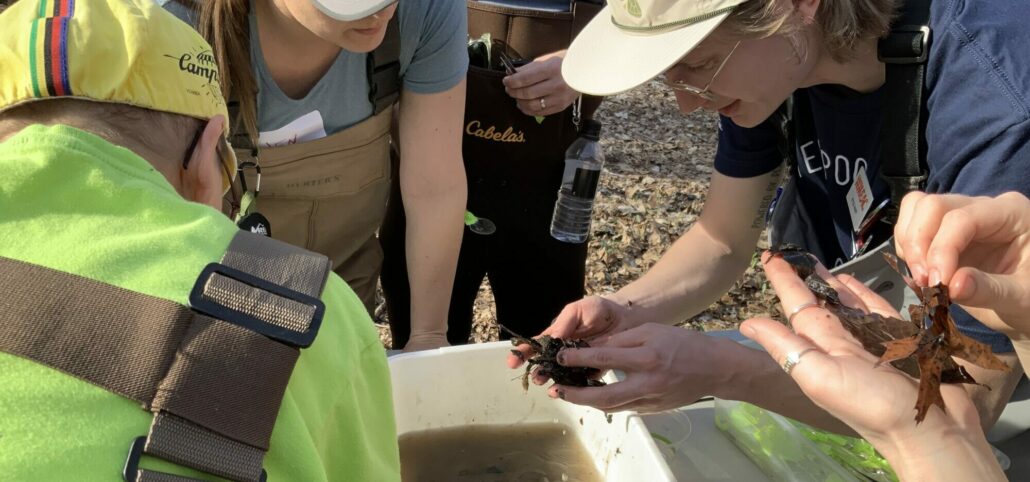By: Kelly Otterness
Waist-deep in the cool stream, with our waterproof “waders” hugging our bodies, WMEAC’s Adopt-A-Stream volunteers started to boogie down. Our boots danced and dragged along the silt, kicking up mud—and hopefully bug larvae—into nets waiting downstream.
We had just learned the latest dance craze, the “substrate shuffle,” from the training workshop’s organizers, Carlos Calderon (Director of Sustainable Community Development) and Kyle Hart (Education Programs Manager). Our sweet moves would help WMEAC to collect buckets of larvae from the stream for identification. Because some bugs are more tolerant of pollution than others, the insect larvae we find are an indication of how clean or polluted the stream is.
The workshop was one of two that WMEAC holds each April to train about 15 people. Volunteers are still needed! You can join sampling workshops this weekend (May 26th and 27th) at Buck Creek and next weekend (June 19th and 20th) at Plaster Creek.
WMEAC shares the data we collect with the state of Michigan to help determine whether the last 5, 20, and 50 years of environmental protections have improved the quality of its waterways, Carlos told us. “The more we sample,” he added, “the better informed the state is when making decisions about things like construction and infrastructure projects.”

To collect this data, we waded into Plaster Creek, which is “an impaired but intact ecosystem,” Carlos said. Some say the stream is the most polluted in all of Michigan, others limit it to West Michigan. What’s clear is that the stream no longer lives up to its original name, Ken-O-Sha, which means “Water of the Walleye” to Indigenous Odaawaa people. Walleye can live up to 29 years, yet none of these hardy fish have survived the stream’s pollution. After years of gypsum mining on its shores, the waters of the walleye earned the much sadder name of “Plaster Creek.” Though the mining stopped after a change in sheetrocking material, the walleye have not yet been able to return.
Devoted volunteers are working to change that by making the stream healthy once more. We encountered another group of environmentalists along the banks of the stream who had started cleaning up trash at 8:30 a.m. on a Saturday! Rumor has it that a local volunteer named Frank also walks through Ken-O-Sha Park with a trash bag twice a day.
Local passion for restoring Ken-O-Sha stream is growing, too. Curious kids, families, solo hikers, and couples stopped at WMEAC’s larvae identification tables along the trail. Observers marveled at the tiny, alien-like larvae floating in buckets of stream water and squealed as we carefully tweezered squirming specimens into water-filled ice cube trays.
“I love the caddisfly. It’s so cute!” a volunteer said, holding a wiggly larva up with her tweezers.
Some captives were far too large—and precious to Ken-O-Sha’s ecosystem—to keep. One net scooped up a giant mama crayfish, who became a favorite of kids passing by the identification tables. When we turned her over, her tail unfurled to reveal a bundle of eggs. Like all of the other crayfish we scooped up, who are crucial to the stream’s ecosystem and health, we returned the mama to her home waters.
Since the training workshops do not follow the strict timing and preservation protocols of an actual sampling session, some of the remaining samples are usually up for grabs. Two college students—who said they joined the workshop to “gain perspective” after Carlos spoke in one of their environmental classes—happily left with a souvenir, a sowbug they named “Jimmy.”
If you’d like to help WMEAC and the state of Michigan gain perspective on the health of your local waterways, or simply add the “substrate shuffle” to your dance moves, stay tuned for June’s Adopt-A-Stream training and sampling events by signing up for our volunteer newsletter. Also check out our website’s events calendar and e-news for our Rain Barrel workshops held each spring and summer, where you can receive a free rain barrel and learn to set it up to reduce stormwater runoff.

